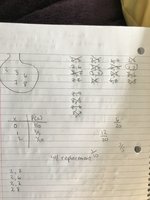I am stuck on the following Question. I worked out the answer for replacement but I am completely lost on the "without replacement" aspect. Any help or explaination would be greatly appreciated
A bag contains five tokens numbered 2, 3, 6, 7, and 8.
Two tokens are taken in succession out of the bag without replacement.
a) Create the probability distribution for “x” being the number of odd numbered
tokens drawn.
A bag contains five tokens numbered 2, 3, 6, 7, and 8.
Two tokens are taken in succession out of the bag without replacement.
a) Create the probability distribution for “x” being the number of odd numbered
tokens drawn.

